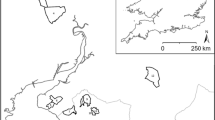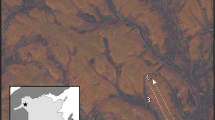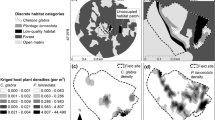Abstract
This study investigates the sensitivity of local synchrony to movement patterns of the Ringlet butterfly (Aphantopus hyperantus). We examine whether population synchrony, describing the correlated fluctuations of conspecific populations, may prove an effective surrogate measure for monitoring functional connectivity in this species without the requirement of exhaustive sampling. We compared the effect on population synchrony of two different distance measures, direct (Euclidean) distance and distance via woodland rides and edges, and also of habitat matrix composition. Population synchrony of A. hyperantus was calculated as the pairwise correlation between population time-series using 20 years of data from UK butterfly monitoring scheme transects. Local population synchrony was better explained by distance via woodland edges than direct distance, especially for woodland-dominated transects. These results are consistent with mark-recapture data previously collected on the Ringlet butterfly. The results indicate a sensitivity of population synchrony to butterfly local dispersal behaviour, particularly, to the use of habitat corridors and other functional dispersal routes. Population synchrony is considered to have potential as a surrogate measure of functional connectivity. With development, this method could become a valuable conservation tool for identifying important landscape features which promote species’ connectivity.



Similar content being viewed by others
References
Andreassen HP, Hertzberg K, Ims RA (1998) Space-use responses to habitat fragmentation and connectivity in the root vole Microtus oeconomus. Ecology 79:1223–1235
Bellamy PE, Rothery P, Hinsley SA (2003) Synchrony of woodland bird populations: the effect of landscape structure. Ecography 26:338–348
Benton TG, Lapsley CT, Beckerman AP (2001) Population synchrony and environmental variation: an experimental demonstration. Ecol Lett 4:236–243
Bjørnstad ON, Ims RA, Lambin X (1999) Spatial population dynamics: analyzing patterns and processes of population synchrony. Trends Ecol Evol 14:427–432
Burnham KP, Anderson DR (2010) Model selection and multi-model inference: a practical information-theoretic approach, 2nd edn. Springer, New York
Casula P (2006) Evaluating hypotheses about dispersal in a vulnerable butterfly. Ecol Res 21:263–270
Chardon JP, Adriaensen F, Matthysen E (2003) Incorporating landscape elements into a connectivity measure: a case study for the Speckled wood butterfly (Parage aegeria L.). Landscape Ecol 18:561–573
Clegg SM, Kelly JF, Kimura M, Smith TB (2003) Combining genetic markers and stable isotopes to reveal population connectivity and migration patterns in a Neotropical migrant, Wilson’s warbler (Wilsonia pusilla). Mol Ecol 12:819–830
den Boer PJ (1981) On the survival of populations in a heterogeneous and variable environment. Oecologia 50:39–53
Fontaine C, Gonzalez A (2005) Population synchrony induced by resource fluctuations and dispersal in an aquatic microcosm. Ecology 86:1463–1471
Fox R, Asher J, Brereton T, Roy DB, Warren M (2006) The state of butterflies in Britain and Ireland. Pisces Publications, Oxford
González-Megías A, Menéndez R, Roy DB, Brereton T, Thomas CD (2008) Changes in the composition of British butterfly assemblages over two decades. Glob Chang Biol 14:1464–1474
Haddad NM (1999) Corridor use predicted from behaviors at habitat boundaries. Am Nat 153:215–227
Haddad NM, Holyoak M, Mata TM, Davies KF, Melboune BA, Preston K (2008) Species’ traits predict the effects of disturbance and productivity on diversity. Ecol Lett 11:348–356
Hanski I (1994) A practical model of metapopulation dynamics. J Anim Ecol 63:151–162
Hanski I (1999) Metapopulation ecology. Oxford University Press, Oxford
Hanski I, Gilpin ME (1997) Metapopulation biology: ecology, genetics and evolution. Academic Press, San Diego
Hanski I, Woiwod IP (1993) Spatial synchrony in the dynamics of moth and aphid populations. J Anim Ecol 62:656–668
Hudson PJ, Cattadori IM (1999) The Moran effect: a cause of population synchrony. Trends Ecol Evol 14:1–2
Kendall BE, Bjørnstad ON, Bascompte J, Keitt TH, Fagan WF (2000) Dispersal, environmental correlation, and spatial synchrony in population dynamics. Am Nat 155:628–636
Kerlin DH, Haydon DT, Miller D, Aebischer NJ, Smith AA, Thirgood SJ (2007) Spatial synchrony in red grouse population dynamics. Oikos 116:2007–2016
Keyghobadi N, Roland J, Strobeck C (2005) Genetic differentiation and gene flow among populations of the alpine butterfly, Parnassius smintheus, vary with landscape connectivity. Mol Ecol 14:1897–1909
Kiviniemi K, Löfgren A (2009) Spatial (a)synchrony in population fluctuations of five plant species in fragmented habitats. Basic Appl Ecol 10:70–78
Koenig WD (1999) Spatial autocorrelation of ecological phenomena. Trends Ecol Evol 14:22–26
Kuefler D, Haddad NM (2006) Local versus landscape determinants of butterfly movement behaviors. Ecography 29:549–560
Lande R, Engen S, Sæther B-E (1999) Spatial scale of population synchrony: environmental correlation versus dispersal and density regulation. Am Nat 154:271–281
Liebhold A, Koenig WD, Bjørnstad ON (2004) Spatial synchrony in population dynamics. Ann Rev Ecol Evol Syst 35:467–490
Liebhold AM, Johnson DM, Bjørnstad ON (2006) Geographic variation in density-dependent dynamics impacts the synchronizing effect of dispersal and regional stochasticity. Popul Ecol 48:131–138
Moilanen A, Hanski IA (1998) Metapopulation dynamics: effects of habitat quality and landscape structure. Ecology 79:2503–2515
Moilanen A, Hanski IA (2001) On the use of connectivity measures in spatial ecology. Oikos 95:147–151
Moran PAP (1953) The statistical analysis of the Canadian lynx cycle II synchronization and meteorology. Aust J Zool 1:291–298
Oliver TH, Roy DB, Hill JK, Brereton T, Thomas CD (2010) Heterogeneous landscapes promote population stability. Ecol Lett 13:473–484
Oliver TH, Roy DB, Brereton T, Thomas JA (2012) Reduced variability in range-edge butterfly populations over three decades of climate warming. Glob Chang Biol 18:1531–1539
Ouin A, Martin M, Burel F (2008) Agricultural landscape connectivity for the meadow brown butterfly (Maniola jurtina). Agric Ecosyst Environ 124:193–199
Paradis E, Baillie SR, Sutherland WJ, Gregory RD (1999) Dispersal and spatial scale affect synchrony in spatial population dynamics. Ecol Lett 2:114–120
Paradis E, Baillie SR, Sutherland WJ, Gregory RD (2000) Spatial synchrony in populations of birds: effects of habitat, population trend, and spatial scale. Ecology 81:2112–2125
Pollard E (1991) Synchrony of population fluctuation: the dominant influence of widespread factors on local butterfly populations. Oikos 60:7–10
Pollard E, Yates TJ (1993) Monitoring butterflies for ecology and conservation. Chapman and Hall, London
Post E, Forchhammer MC (2004) Spatial synchrony of local populations has increased in association with the recent Northern Hemisphere climate trend. Proc Natl Acad Sci 101:9286–9290
Powney GD, Roy DB, Chapman D, Oliver TH (2010) Synchrony of butterfly populations across species’ geographic ranges. Oikos 119:1690–1696
Powney GD, Roy DB, Chapman D, Brereton T, Oliver TH (2011) Measuring functional connectivity using long-term monitoring data. Methods Ecol Evol 2:527–533
R Development Core Team (2010) R: a language and environment for statistical computing. R Foundation for Statistical Computing, Vienna, Austria. ISBN 3-900051-07-0, URL http://www.R-project.org/
Raimondo S, Liebhold AM, Strazanac JS, Butler L (2004) Population synchrony within and among Lepidoptera species in relation to weather, phylogeny, and larval phenology. Ecol Entomol 29:96–105
Ranta E, Kaitala V, Lindstrom J, Helle E (1997) The Moran effect and synchrony in population dynamics. Oikos 78:136–142
Ricketts TH (2001) The matrix matters: effective isolation in fragmented landscapes. Am Nat 158:87–99
Roland J, Matter SF (2007) Encroaching forests decouple alpine butterfly population dynamics. Proc Natl Acad Sci 104:13702–13704
Roland J, Keyghobadi N, Fownes S (2000) Alpine Parnassius butterfly dispersal: effects of landscape and population size. Ecology 81:1642–1653
Rothery P, Roy DB (2001) Application of generalized additive models to butterfly transect count data. J Appl Stat 28:897–909
Rubenstein DR, Hobson KA (2004) From birds to butterflies: animal movement patterns and stable isotopes. Trends Ecol Evol 19:256–262
Schneider C, Fry G (2005) Estimating the consequences of land-use changes on butterfly diversity in a marginal agricultural landscape in Sweden. J Nat Conserv 13:247–256
Schtickzelle N, Baguette M (2003) Behavioural responses to habitat patch boundaries restrict dispersal and generate emigration-patch area relationships in fragmented landscapes. J Anim Ecol 72:533–545
Schwartz MK, Mills LS, McKeivey KS, Ruggiero LF, Allendorf FW (2002) DNA reveals high dispersal synchronizing the population dynamics of Canada lynx. Nature 415:520–522
Sutcliffe OL, Thomas CD (1996) Open corridors appear to facilitate dispersal by ringlet butterflies (Aphantopus hyperantus) between woodland clearings. Conserv Biol 10:1359–1365
Sutcliffe OL, Thomas CD, Moss D (1996) Spatial synchrony and asynchrony in butterfly population dynamics. J Anim Ecol 65:85–95
Sutcliffe OL, Thomas CD, Peggie D (1997a) Area-dependent migration by ringlet butterflies generates a mixture of patchy population and metapopulation attributes. Oecologica 109:229–234
Sutcliffe OL, Thomas CD, Yates TJ, Greatorex-Davies JN (1997b) Correlated extinctions, colonizations and population fluctuations in a highly connected ringlet butterfly metapopulation. Oecologica 109:235–241
Sutcliffe OL, Bakkestuen V, Fry G, Stabbetorp OE (2003) Modelling the benefits of farmland restoration: methodology and application to butterfly movement. Landsc Urban Plan 63:15–31
Swanson BJ, Johnson DR (1999) Distinguishing causes of intraspecific synchrony in population dynamics. Oikos 86:265–274
Thomas CD (1991) Spatial and temporal variability in a butterfly population. Oecologia 87:577–580
Thomas JA (2005) Monitoring change in the abundance and distribution of insects using butterflies and other indicator groups. Philos Trans R Soc B 360:339–357
Thomas JA, Moss D, Pollard E (1994) Increased fluctuations of butterfly populations towards the northern edges of species’ ranges. Oikos 17:215–220
Tischendorf L, Fahrig L (2000) On the usage and measurement of landscape connectivity. Oikos 90:7–19
van Swaay CAM, Noiwicki P, Settele J, van Strien AJ (2008) Butterfly monitoring in Europe: methods, applications and perspectives. Biodivers Conserv 17:3455–3469
Acknowledgments
We are very grateful to all the recorders who contribute to the UKBMS. The UKBMS is a partnership between Butterfly Conservation and the Natural Environment Research Council, Centre for Ecology and Hydrology. The UKBMS is co-funded by a consortium of government agencies, led by Defra. We thank Steve Freeman, Colin Harrower and John Redhead for statistics and GIS advice. We also thank Odette Sutcliffe, Kevin Watts, Chris Thomas, Jane Hill, Tom Brereton, and two anonymous reviewers for useful discussion.
Author information
Authors and Affiliations
Corresponding author
Electronic supplementary material
Below is the link to the electronic supplementary material.
Rights and permissions
About this article
Cite this article
Powney, G.D., Broaders, L.K. & Oliver, T.H. Towards a measure of functional connectivity: local synchrony matches small scale movements in a woodland edge butterfly. Landscape Ecol 27, 1109–1120 (2012). https://doi.org/10.1007/s10980-012-9771-y
Received:
Accepted:
Published:
Issue Date:
DOI: https://doi.org/10.1007/s10980-012-9771-y




